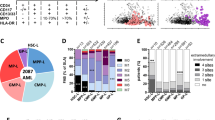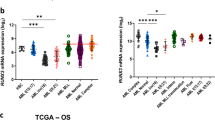Abstract
The inhibitors of DNA binding (ID) inhibit basic helix-loop-helix transcription factors and thereby guide cellular differentiation and proliferation. To elucidate the involvement of IDs in hematopoiesis and acute leukemias (AL), we analyzed ID2 and ID3 expression in hematopoiesis and leukemic blasts in bone marrow biopsies (BMB). BMB of healthy stem cell donors (n = 19) and BMB of patients with acute myeloid leukemia (AML) with myelodysplasia-related changes (AML-MD; n = 19), de novo AML (n = 20), B-acute lymphoblastic leukemia (B-ALL) (n = 23), T-ALL (n = 19), were immunohistochemically stained for ID2 and ID3 expression. The expression patterns were evaluated and quantified for each hematopoietic lineage and each leukemia subtype. In normal BMB, immature granulopoiesis showed weak ID2 and strong ID3 expression, which was lost during maturation (p < 0.001). Erythropoiesis remained negative for ID2/3 (p < 0.001). ID2/3 expression differed between immature granulopoiesis and leukemic blasts (p < 0.001). Moreover, differential ID2/3 expression was seen between AL subgroups: AML, especially AML-MD, had more ID2- (p < 0.001) and ID3-positive (p < 0.001) blasts than ALL. We show a comprehensive in situ picture of ID2/3 expression in hematopoiesis and AL. Morphologically, ID2/3 proteins seem to be involved in the granulopoietic maturation. Importantly, the distinct ID2/3 expression patterns in AL indicate a specific deregulation of ID2/3 in the various types of AL and may support subtyping of AL.




Similar content being viewed by others
References
Akashi K, He X, Chen J, Iwasaki H, Niu C, Steenhard B, Zhang J, Haug J, Li L (2003) Transcriptional accessibility for genes of multiple tissues and hematopoietic lineages is hierarchically controlled during early hematopoiesis. Blood 101:383–389
Aspland SE, Bendall HH, Murre C (2001) The role of E2A–PBX1 in leukemogenesis. Oncogene 20:5708–5717
Back J, Dierich A, Bronn C, Kastner P, Chan S (2004) PU.1 determines the self-renewal capacity of erythroid progenitor cells. Blood 103:3615–3623
Benezra R, Davis RL, Lockshon D, Turner DL, Weintraub H (1990) The protein Id: a negative regulator of helix-loop-helix DNA binding proteins. Cell 61:49–59
Benezra R, Rafii S, Lyden D (2001) The Id proteins and angiogenesis. Oncogene 20:8334–8341
Buitenhuis M, van Deutekom HW, Verhagen LP, Castor A, Jacobsen SE, Lammers JW, Koenderman L, Coffer PJ (2005) Differential regulation of granulopoiesis by the basic helix-loop-helix transcriptional inhibitors Id1 and Id2. Blood 105:4272–4281
Cooper CL, Brady G, Bilia F, Iscove NN, Quesenberry PJ (1997) Expression of the Id family helix-loop-helix regulators during growth and development in the hematopoietic system. Blood 89:3155–3165
Doulatov S, Notta F, Rice KL, Howell L, Zelent A, Licht JD, Dick JE (2009) PLZF is a regulator of homeostatic and cytokine-induced myeloid development. Genes Dev 23:2076–2087
Gardini A, Cesaroni M, Luzi L, Okumura AJ, Biggs JR, Minardi SP, Venturini E, Zhang DE, Pelicci PG, Alcalay M (2008) AML1/ETO oncoprotein is directed to AML1 binding regions and co-localizes with AML1 and HEB on its targets. PLoS Genet 4:e1000275
Guo C, Hu Q, Yan C, Zhang J (2009) Multivalent binding of the ETO corepressor to E proteins facilitates dual repression controls targeting chromatin and the basal transcription machinery. Mol Cell Biol 29:2644–2657
Hasskarl J, Münger K (2002) Id proteins–tumor markers or oncogenes? Cancer Biol Ther 1:91–96
Hong SH, Lee JH, Lee JB, Ji J, Bhatia M (2011) ID1 and ID3 represent conserved negative regulators of human embryonic and induced pluripotent stem cell hematopoiesis. J Cell Sci 124:1445–1452
Hunger SP (1996) Chromosomal translocations involving the E2A gene in acute lymphoblastic leukemia: clinical features and molecular pathogenesis. Blood 87:1211–1224
Hunger SP, Ohyashiki K, Toyama K, Cleary ML (1992) Hlf, a novel hepatic bZIP protein, shows altered DNA-binding properties following fusion to E2A in t (17;19) acute lymphoblastic leukemia. Genes Dev 6:1608–1620
Inaba T, Roberts WM, Shapiro LH, Jolly KW, Raimondi SC, Smith SD, Look AT (1992) Fusion of the leucine zipper gene HLF to the E2A gene in human acute B-lineage leukemia. Science 257:531–534
Ishiguro A, Spirin KS, Shiohara M, Tobler A, Gombart AF, Israel MA, Norton JD, Koeffler HP (1996) Id2 expression increases with differentiation of human myeloid cells. Blood 87:5225–5231
Ji M, Li H, Suh HC, Klarmann KD, Yokota Y, Keller JR (2008) Id2 intrinsically regulates lymphoid and erythroid development via interaction with different target proteins. Blood 112:1068–1077
Kreider BL, Benezra R, Rovera G, Kadesch T (1992) Inhibition of myeloid differentiation by the helix-loop-helix protein Id. Science 255:1700–1702
Laiosa CV, Stadtfeld M, Graf T (2006) Determinants of lymphoid–myeloid lineage diversification. Annu Rev Immunol 24:705–738
Laslo P, Spooner CJ, Warmflash A, Lancki DW, Lee HJ, Sciammas R, Gantner BN, Dinner AR, Singh H (2006) Multilineage transcriptional priming and determination of alternate hematopoietic cell fates. Cell 126:755–766
Laslo P, Pongubala JM, Lancki DW, Singh H (2008) Gene regulatory networks directing myeloid and lymphoid cell fates within the immune system. Semin Immunol 20:228–235
Lasorella A, Iavarone A, Israel MA (1996) Id2 specifically alters regulation of the cell cycle by tumor suppressor proteins. Mol Cell Biol 16:2570–2578
Lasorella A, Boldrini R, Dominici C, Donfrancesco A, Yokota Y, Inserra A, Iavarone A (2002) Id2 is critical for cellular proliferation and is the oncogenic effector of N-myc in human neuroblastoma. Cancer Res 62:301–306
Lasorella A, Stegmuller J, Guardavaccaro D, Liu G, Carro MS, Rothschild G, de la Torre-Ubieta L, Pagano M, Bonni A, Iavarone A (2006) Degradation of Id2 by the anaphase-promoting complex couples cell cycle exit and axonal growth. Nature 442:471–474
Leeanansaksiri W, Wang H, Gooya JM, Renn K, Abshari M, Tsai S, Keller JR (2005) IL-3 induces inhibitor of DNA-binding protein-1 in hemopoietic progenitor cells and promotes myeloid cell development. J Immunol 174:7014–7021
Li H, Ji M, Klarmann KD, Keller JR (2010) Repression of Id2 expression by Gfi-1 is required for B-cell and myeloid development. Blood 116:1060–1069
Lister J, Forrester WC, Baron MH (1995) Inhibition of an erythroid differentiation switch by the helix-loop-helix protein Id1. J Biol Chem 270:17939–17946
Lyden D, Young AZ, Zagzag D, Yan W, Gerald W, O’Reilly R, Bader BL, Hynes RO, Zhuang Y, Manova K, Benezra R (1999) Id1 and Id3 are required for neurogenesis, angiogenesis and vascularization of tumour xenografts. Nature 401:670–677
Manthey C, Mern DS, Gutmann A, Zielinski AJ, Herz C, Lassmann S, Hasskarl J (2010) Elevated endogenous expression of the dominant negative basic helix-loop-helix protein ID1 correlates with significant centrosome abnormalities in human tumor cells. BMC Cell Biol 11:2
Maruyama H, Kleeff J, Wildi S, Friess H, Buchler MW, Israel MA, Korc M (1999) Id-1 and Id-2 are overexpressed in pancreatic cancer and in dysplastic lesions in chronic pancreatitis. Am J Pathol 155:815–822
Maruyama T, Li J, Vaque JP, Konkel JE, Wang W, Zhang B, Zhang P, Zamarron BF, Yu D, Wu Y, Zhuang Y, Gutkind JS, Chen W (2011) Control of the differentiation of regulatory T cells and T(H)17 cells by the DNA-binding inhibitor Id3. Nat Immunol 12:86–95
Massari ME, Murre C (2000) Helix-loop-helix proteins: regulators of transcription in eucaryotic organisms. Mol Cell Biol 20:429–440
Maw MK, Fujimoto J, Tamaya T (2009) Overexpression of inhibitor of DNA-binding (ID)-1 protein related to angiogenesis in tumor advancement of ovarian cancers. BMC Cancer 9:430
Mellentin JD, Murre C, Donlon TA, McCaw PS, Smith SD, Carroll AJ, McDonald ME, Baltimore D, Cleary ML (1989) The gene for enhancer binding proteins E12/E47 lies at the t (1;19) breakpoint in acute leukemias. Science 246:379–382
Mern DS, Hasskarl J, Burwinkel B (2010a) Inhibition of Id proteins by a peptide aptamer induces cell-cycle arrest and apoptosis in ovarian cancer cells. Br J Cancer 103:1237–1244
Mern DS, Hoppe-Seyler K, Hoppe-Seyler F, Hasskarl J, Burwinkel B (2010b) Targeting Id1 and Id3 by a specific peptide aptamer induces E-box promoter activity, cell cycle arrest, and apoptosis in breast cancer cells. Breast Cancer Res Treat 124:623–633
Mufti GJ, Flandrin G, Schaefer H-E, Sandberg AA, Kanfer EJ (1996) An atlas of malignant haematology: cytology, histology and cytogenetics. Martin Dunitz Ltd, London
Münch C, May AM, Hauschke D, Roth J, Lassmann S, Werner M (2011) Internuclear chromosome distribution of dysplastic megakaryocytes in myelodysplastic syndromes is dependent on the level of ploidy. Chromosoma 120:265–273
Nigten J, Breems-de Ridder MC, Erpelinck-Verschueren CA, Nikoloski G, van der Reijden BA, van Wageningen S, van Hennik PB, de Witte T, Lowenberg B, Jansen JH (2005) ID1 and ID2 are retinoic acid responsive genes and induce a G0/G1 accumulation in acute promyelocytic leukemia cells. Leukemia 19:799–805
Nogueira MM, Mitjavila-Garcia MT, Le Pesteur F, Filippi MD, Vainchenker W, Dubart Kupperschmitt A, Sainteny F (2000) Regulation of Id gene expression during embryonic stem cell-derived hematopoietic differentiation. Biochem Biophys Res Commun 276:803–812
Norton JD (2000) ID helix-loop-helix proteins in cell growth, differentiation and tumorigenesis. J Cell Sci 113(Pt 22):3897–3905
Ouyang XS, Wang X, Lee DT, Tsao SW, Wong YC (2002) Over expression of ID-1 in prostate cancer. J Urol 167:2598–2602
Pascal LE, True LD, Campbell DS, Deutsch EW, Risk M, Coleman IM, Eichner LJ, Nelson PS, Liu AY (2008) Correlation of mRNA and protein levels: cell type-specific gene expression of cluster designation antigens in the prostate. BMC Genomics 9:246
Perk J, Iavarone A, Benezra R (2005) Id family of helix-loop-helix proteins in cancer. Nat Rev Cancer 5:603–614
Perk J, Gil-Bazo I, Chin Y, de Candia P, Chen JJ, Zhao Y, Chao S, Cheong W, Ke Y, Al-Ahmadie H, Gerald WL, Brogi E, Benezra R (2006) Reassessment of id1 protein expression in human mammary, prostate, and bladder cancers using a monospecific rabbit monoclonal anti-id1 antibody. Cancer Res 66:10870–10877
Quesenberry PJ, Iscove NN, Cooper C, Brady G, Newburger PE, Stein GS, Stein JS, Reddy GP, Pearson-White S (1996) Expression of basic helix-loop-helix transcription factors in explant hematopoietic progenitors. J Cell Biochem 61:478–488
Sikder HA, Devlin MK, Dunlap S, Ryu B, Alani RM (2003) Id proteins in cell growth and tumorigenesis. Cancer Cell 3:525–530
Suh HC, Leeanansaksiri W, Ji M, Klarmann KD, Renn K, Gooya J, Smith D, McNiece I, Lugthart S, Valk PJ, Delwel R, Keller JR (2008) Id1 immortalizes hematopoietic progenitors in vitro and promotes a myeloproliferative disease in vivo. Oncogene 27:5612–5623
Sun XH, Copeland NG, Jenkins NA, Baltimore D (1991) Id proteins Id1 and Id2 selectively inhibit DNA binding by one class of helix-loop-helix proteins. Mol Cell Biol 11:5603–5611
Tang R, Hirsch P, Fava F, Lapusan S, Marzac C, Teyssandier I, Pardo J, Marie JP, Legrand O (2009) High Id1 expression is associated with poor prognosis in 237 patients with acute myeloid leukemia. Blood 114:2993–3000
Wazir U, Jiang WG, Sharma AK, Newbold RF, Mokbel K (2013) The mRNA expression of inhibitors of DNA binding-1 and -2 is associated with advanced tumour stage and adverse clinical outcome in human breast cancer. Anticancer Res 33:2179–2183
Wilson JW, Deed RW, Inoue T, Balzi M, Becciolini A, Faraoni P, Potten CS, Norton JD (2001) Expression of Id helix-loop-helix proteins in colorectal adenocarcinoma correlates with p53 expression and mitotic index. Cancer Res 61:8803–8810
Wong YC, Wang X, Ling MT (2004) Id-1 expression and cell survival. Apoptosis 9:279–289
Yang HY, Liu HL, Ke J, Wu H, Zhu H, Liu JR, Liu LX, Jiang HC (2010) Expression and prognostic value of Id protein family in human breast carcinoma. Oncol Rep 23:321–328
Yang HY, Liu HL, Liu GY, Zhu H, Meng QW, Qu LD, Liu LX, Jiang HC (2011) Expression and prognostic values of Id-1 and Id-3 in gastric adenocarcinoma. J Surg Res 167:258–266
Yokota Y, Mori S (2002) Role of Id family proteins in growth control. J Cell Physiol 190:21–28
Zebedee Z, Hara E (2001) Id proteins in cell cycle control and cellular senescence. Oncogene 20:8317–8325
Acknowledgments
The authors thank Mrs. Katja Thurig for excellent technical assistance. ML, JH, and SL received funding for this study by the Deutsche-Jose-Carreras-Leukaemie-Stiftung (Grant No. DJCLS R 09/26).
Author information
Authors and Affiliations
Corresponding author
Rights and permissions
About this article
Cite this article
May, A.M., Frey, AV., Bogatyreva, L. et al. ID2 and ID3 protein expression mirrors granulopoietic maturation and discriminates between acute leukemia subtypes. Histochem Cell Biol 141, 431–440 (2014). https://doi.org/10.1007/s00418-013-1169-7
Accepted:
Published:
Issue Date:
DOI: https://doi.org/10.1007/s00418-013-1169-7




